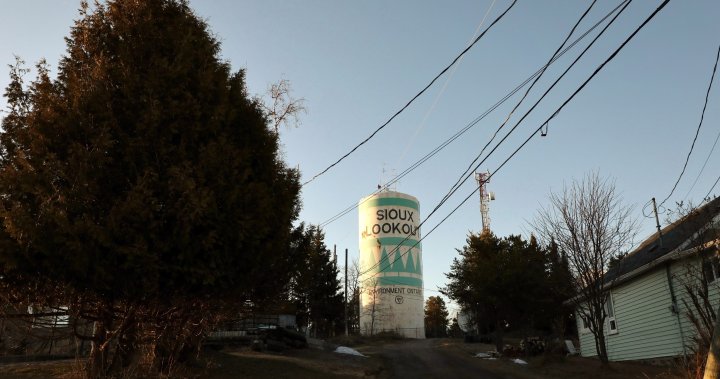More than 1,000 miles north of the Greater Toronto Area, far away from the Greenbelt scandal and spats over who should pay for refugee shelter spaces, is a community that has been struggling to keep pace as it grows.
Despite not sharing the spotlight with cities and towns in southern Ontario, local advocates say many housing issues are just as bad in the north as they are in the province’s most populated areas.
In the town of Sioux Lookout, Ont., which acts as a key health care and service hub for tens of thousands of people, housing pressures — and costs — can be immense.
“What surprises people in the south is that rents in Sioux Lookout rival what you pay in Toronto,” Henry Wall, CEO of the Kenora District Services Board, told Global News.
In a town where more than 25,000 people travel in every year for appointments and local groups struggle to solve transient homelessness and encampments, the sense of injustice is palpable.
“Part of the frustration for small towns is so much money gets poured into the large centres to address things and we don’t (get the same funding),” Mayor Doug Lawrance told Global News.
The town acts as a health care hub for some 30 First Nations communities, with local populations also growing for years.
In 2011, census data shows there were 5,037 people living in Sioux Lookout, a town which sits over four hours north of Thunder Bay by road.
That number jumped five per cent to 5,272 in 2016, and again by 11 per cent to 5,839 in 2021.
Over the same decade, Toronto’s population grew by roughly seven per cent.
While the local population was growing in Sioux Lookout, the number of homes failed to keep pace.
Data shared with Global News by the town’s planning department shows that only 333 new units were built from 2011 to 2021. Factoring in the 61 units that were demolished, the town only added 272 new units over a decade when its population jumped by more than 800 people.
Wall said the need in Sioux Lookout is just as acute as in the south, where it feels like most governmental attention has gone.
“Small, rural communities need just as much support when it comes to addressing its housing crisis as large urban centres (do),” he told Global News, arguing homelessness is not only a challenge for large cities.
“As you can see in Sioux Lookout, it is a very small community but it is having to address (homelessness) more than exceeds — and certainly rivals — some of the worst homeless situations in the country.”
Ontario’s Housing Minister Paul Calandra told Global News he agreed that “more has to happen in northern Ontario over the next number of months.”
He referenced the Ford government’s housing policy reset after the Greenbelt scandal, including a number of reversals, admitting there had not been a major focus on the north.
“We’ve spent a lot of time in southern Ontario in the reset, but now is the time to unleash the economic prosperity that is so vital in northern Ontario,” Calandra said.
The town’s northern location means the construction season for housing is dramatically shorter than it is in the south, with bitter winters making homebuilding a challenge for several months every year.
Getting the right workers to build different projects can also be a challenge, while even the bedrock in northern Ontario is harder to build on than softer grounds in the south.
“The cost of homes, the short build season, the availability of materials… there’s all these unique challenges,” Michael Joseph Cullen, director of community partnerships with Habitat for Humanity Ontario Gateway North, told Global News.
“So there (are) challenges unique to northern Ontario. Travel to different municipalities is a bit further… but I think there’s a lot more opportunity because there is a lot of rural, very, very interested parties, communities and smaller municipalities.”
Henry Wall, CEO of the Kenora District Services Board, said the housing supply in the north has failed to keep up for decades.
“All those things have created a situation where the housing stock, probably since the 1970s, simply hasn’t kept up with the demand for housing,” he said.
“What we are seeing is just overcrowding, the increase in bed use at the emergency shelter. It’s putting pressure on a lot of aspects in the community because we just simply lack housing across the whole entire housing continuum.”
Those challenges have to be baked into housing policy for the north, according to the housing minister.
“It is harder to build homes, it is harder to get around and you need to do more in order to attract people and to keep them in northern Ontario,” Calandra said.
One senior figure with a First Nations-led group in the town pointed out that, although Sioux Lookout has its fair share of vacant land, there are few opportunities to quickly convert existing buildings into beds or homes.
“You’ve got situations like in Sioux Lookout — compared to, say, a bigger urban area — we do not have the luxury of vacant buildings that can be easily retrofitted with minimal renovations to provide that emergency shelter,” Matthew Hoppe, CEO of Independent First Nations Alliance, told Global News, pointing out there aren’t many unused places in the town at all.
Despite the lack of existing infrastructure and years of under-building, there is a sense that parts of the north are ripe to pivot a crisis into solutions. Smaller communities and acre upon acre of vacant land are seen by some as rays of positive potential.
“The smaller communities, for us, have been great — there’s a real appetite for affordable housing of all types,” Cullen said.
“The municipalities, the smaller communities, are very unique because they’re nimble, they can make quick decisions. The larger centres have to deal with more process, more policy, more infrastructure.”
In his 10-minute interview with Global News, Calandra repeatedly pointed out his excitement at the “innovation” coming from northern towns.
The housing situation in Sioux Lookout is made more complicated by the way in which the town acts as a magnet, drawing new residents from both north and south.
A range of large local organizations work hard on recruitment, often drawing new staff from the south.
A large hospital, several health agencies and a significant children’s aid organization all pull workers to Sioux Lookout who need somewhere to live.
“There are these big organizations,” Ontario NDP MPP Sol Mamakwa said, calling for more housing to house the small armies of staff employed by local organizations.
“We have people that live in Dryden who come here to Sioux Lookout — an hour drive one way — each day to work here. It has an impact on everything.”
Calandra said the Ford government was seeing an increase in the number of people moving north, particularly as it tries to push new skills programs and outside the Greater Toronto Area.
“We need more people in northern Ontario — and we’re seeing more people want to get there,” he said.
On the other end, desperate housing situations in some First Nations communities push people off some fly-in reserves to seek shelter in new communities.
“The housing crisis in the far north — and the levels of poverty, the systemic underinvesting in First Nations communities — is pushing people to urban centres,” Wall said.
“It is similar to what is driving the challenge around asylum seekers. People are, in a sense, forced to leave their community because there’s just no room.”
Critics say the province has simply failed to factor those pressures in and is not pitching enough to combat a growing crisis.
“It’s a crime not to invest in affordable housing and housing and in Sioux Lookout especially, because there’s such a need for it,” Mamakwa said.
“Day in and day out we see people… the cost of homes, the cost of rent is just too high.”
As part of its vision to turn Ontario into a global electric vehicle manufacturing hub, the Ford government plans to tap into a series of rare minerals in the peatlands, a place known as the Ring of Fire.
That plan has been controversial with some First Nations communities and would involve the construction of a new, all-season road to access the precious metals buried in the ground.
If the pitch is successful, it will also potentially mean more jobs in the north and an expanded need for housing that goes with them.
“Ensuring the success of the north is going to be vital to securing the success of the south,” Housing Minister Paul Calandra told Global News.
“We can’t be successful in southern Ontario if we aren’t bringing the north with us in these solutions… with a lot of the investment we are seeing in southern Ontario, it is bringing a lot of jobs and opportunities in northern Ontario.”
Calandra said he had committed to “spending a bit more time” in northern Ontario to find “more specific solutions” to unique housing situations facing different communities.
If the government does push ahead with its plans for the Ring of Fire, the NDP’s Sol Mamakwa said he expected them to pay up for needs in the north.
“Most of the time, all they want in the north is the mineral, the resources,” he said.
“But they cannot have those without providing the resources that are needed here in the north.”
This is the second story in a new series set in Sioux Lookout, Ont., titled Hub of the North. Over three features, the series will explore addiction, housing and long-term care in one of Northern Ontario’s most important communities.



